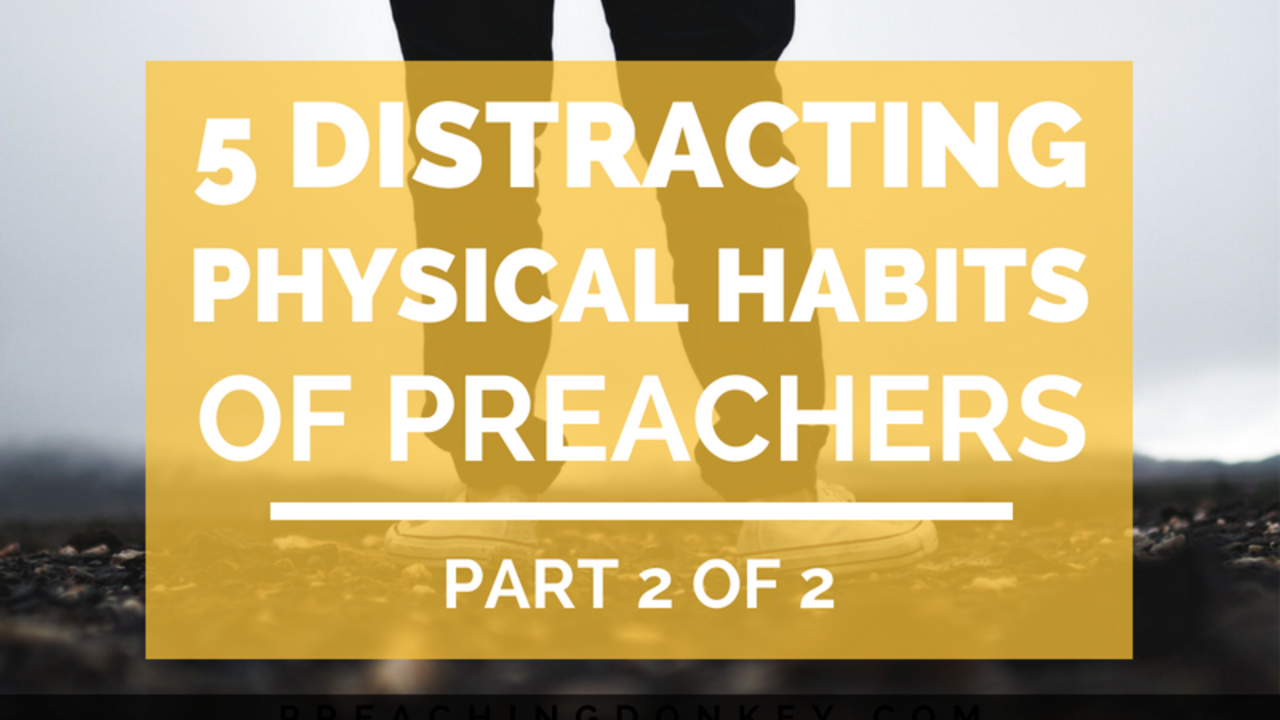Five Distracting Physical Habits of Preachers – Part 2 of 2

Every preacher needs to be aware of a potentially hazardous problem that can show up in their sermon delivery: distracting physical habits. In Part 1 of this series, we looked at the first two distracting physical habits of preachers:
1. Turning your back to the audience to read from the screen
2. Using filler words and vocal pauses
If you missed that post, check it out here. Today we are going to look at three more distracting physical habits of preachers:
3. Aimlessly pacing back and forth on the stage
In college I majored in Communications. In my program, we studied presentation techniques extensively. We examined what works and what doesn’t when it comes to public speaking. And we practiced presenting in front of each other routinely. In the first speech I gave as a freshman, I paced a lot. Back and forth across the room. I was mimicking what I had seen some of my favorite speakers do. Only, their pacing was purposeful and intentional. Mine was aimless. My professor called me out on that and said, “Stop it with the pacing! It adds nothing to your speech.” He was right. There was no intentionality to my pacing and my audience could easily pick up on that.
When I observe preachers’ stage movements, I can often determine whether they’ve thought through their motions and how they come across onstage and if they haven’t. The problem with aimless pacing, especially from one side of the stage to the other, is it wears your listeners out. Not only do they have to pay attention to your content, what you’re saying, but their brains are also trying to make sense of your movements, what you’re doing. If your pacing and movements are incongruent with what you’re saying, your listeners will notice this and get frustrated with you and stop paying attention.
You do not want to risk this. But how do you know what pacing is okay? Should you ditch it altogether and just stand still? Couldn’t pacing be helpful if it is intentional? I would not recommend ditching movement altogether. It can be another tool in your public speaking arsenal if it is intentional and purposeful.
4. Constantly adjusting the head-worn microphone or clothing
A lot could be said about microphone usage while preaching. In a later post I will dive into best practices with mics whether handheld, head-worn, lapel or podium. But for this purposes I want to address a physical distraction when using a head-worn mic. These are increasingly common as the cost of the technology has decreased. A head-worn mic usually consists of a small wire that holds its shape around one of your ears and has a small extension that comes down your cheek just beside your mouth. The actual microphone is on the end of that extension. These mics are designed to be relatively unseen and you don’t have to hold them. The cord goes down your back, best when under your shirt so it is hidden, into a receiver pack that makes the wireless function work.
I see pastors constantly adjusting the cord that goes down their back because their clothing pulls on it. So you’ll see the speaker grab at the cord from just below his ear and pull up. The cord will work its way back down and he’ll pull it up again. This becomes habitual to the preacher and a major distraction for the audience.
There’s an easy fix: Clip the cord to the back of your collar. A lot of Countryman mic kits come with a clip for this purpose, but they get lost or just go unused. If I can’t find the clip, I’ll grab a paper clip and connect it that way. No one can see it and it holds it in place.
Another related distracting habit is the tendency to adjust clothing. Pulling down the shirt, pushing up your sleeves, or worse adjusting the crotch area of your pants… awkward! Avoid these ticks by rehearsing in exactly what you intend to wear when you preach. This will allow you to determine if the ensemble is going to work onstage.
5. Not fully articulating words or finishing sentences
If you’ve ever had to speak on camera and had a good videographer coaching you, you know how important articulation is on camera. Ways of expressing yourself that seem over the top in regular conversation come across as normal on camera. This is why you may be coached to smile bigger, speak louder, articulate clearer, and gesture wider. In the moment it seems ridiculous but any videographer knows that if you don’t express yourself in that way, it will result in a dull outcome.
It is much the same when preaching or public speaking. If you have a tendency to mumble or not finish your words or sentences, it has astronomical effects on how your speech is perceived by your listeners. Perhaps they can’t understand what you said because you didn’t articulate your words clearly. Or they can’t fully hear you because your speaking too quietly without passion. In any case, the failure to articulate is a huge distraction. Practice saying what you’re going to say and make sure each word could stand on its own. Make sure each sentence, each thought, makes sense and could stand on its own as a complete thought. This is a good way to overcome this common habit.
So there you have it! Please don’t be discouraged. At any given time even the most skilled communicators can demonstrate these distracting habits. The key is to be aware of them and work on improving. What are some other distracting things preachers do when giving a sermon?


